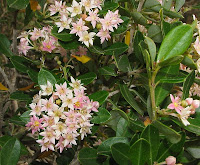Pomaderris myrtilloides
Pomaderris myrtilloides belongs to the Rhamnaceae family, a commercially neglected group of plants despite some being quite spectacular and many able to prosper in very inhospitable environments, consequently they are not well known in gardening circles. Spyridium is another genus in this family and the common name of Dusty Miller may ring a few bells as it is probably one of the better-known Rhamnaceae shrubs. These plants can often be placed within this family by the soft finely matted hairs on the underside of the leaves, young branches, flowering stems and backs of the flowers. Although often mixed with these finely matted hairs, are equally distinctive star shaped hairs (stellate hairs).
The flowers are generally small, but mostly in compact clusters, their color mainly white or cream, although Pomaderris myrtilloides frequently has intermingling pale pink ones, with flowering individuals predominantly one color or the other. This species can be found from Albany to the Nullarbor Plain, however it is very habitat specific and strongly associated with coastal limestone, which may be deeply formed, overlie granite, or shallowly covered by sand.
Pomaderris myrtilloides has soft leaves to 2 cm (¾”) in length and locally is a compact bushy shrub seldom exceeding a metre (4’) in height, although it is known to grow twice that size. It is a long flowering species and will grow in full sun or semi-shade to produce dazzling displays from April to September, although this is dependant on local rainfall/temperatures that can delay or encourage floral development.
Individual flowers (most likely insect pollinated) are to 6 mm (1/4”) diameter and form rounded clusters to 2 cm (3/4”), which are themselves commonly packed tightly together to produce compact floral displays. Interestingly, the petals with this group are either very small or not existent; in the photos you can just make out the thin petals between the much broader and petal-like sepals.





